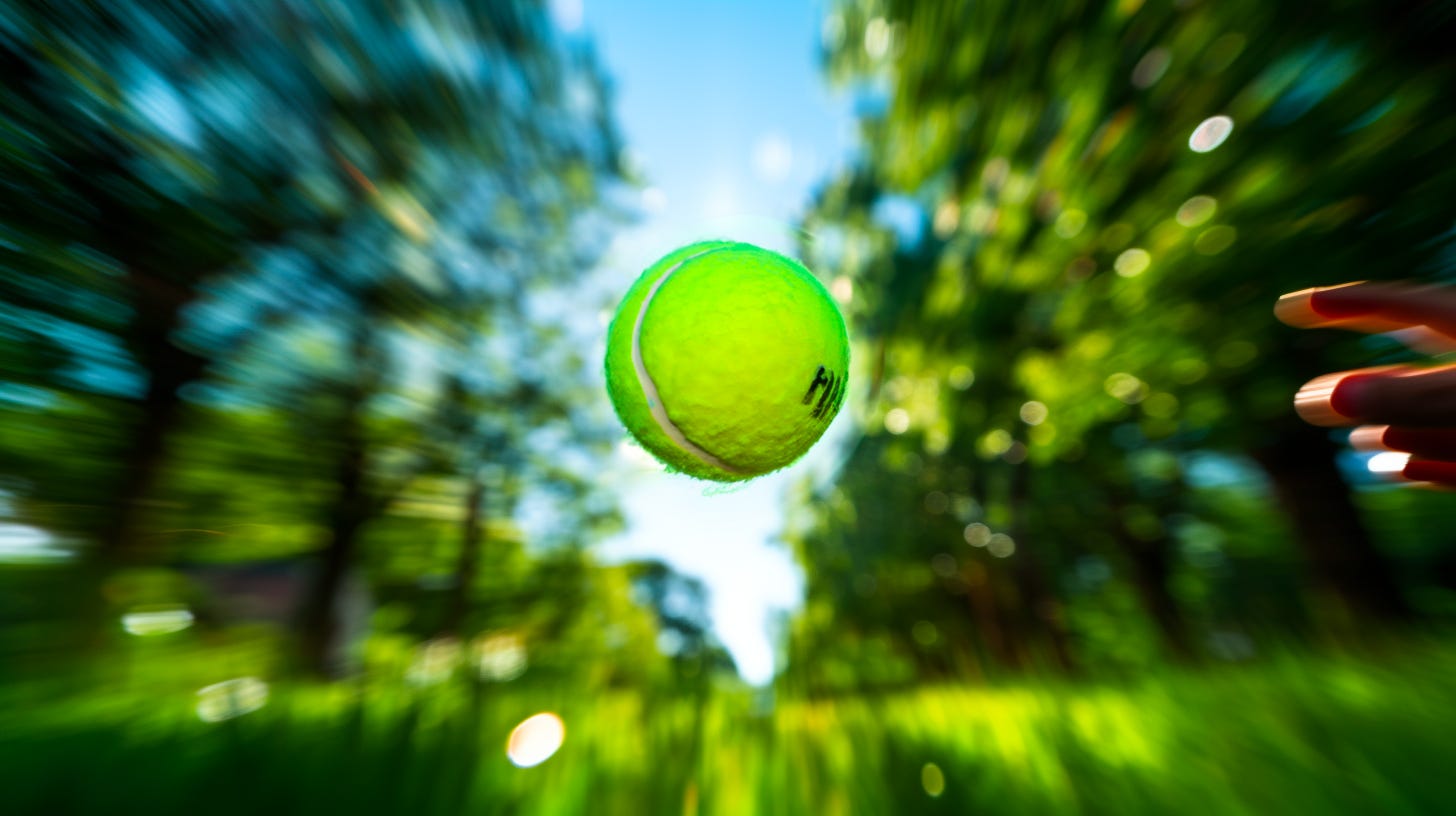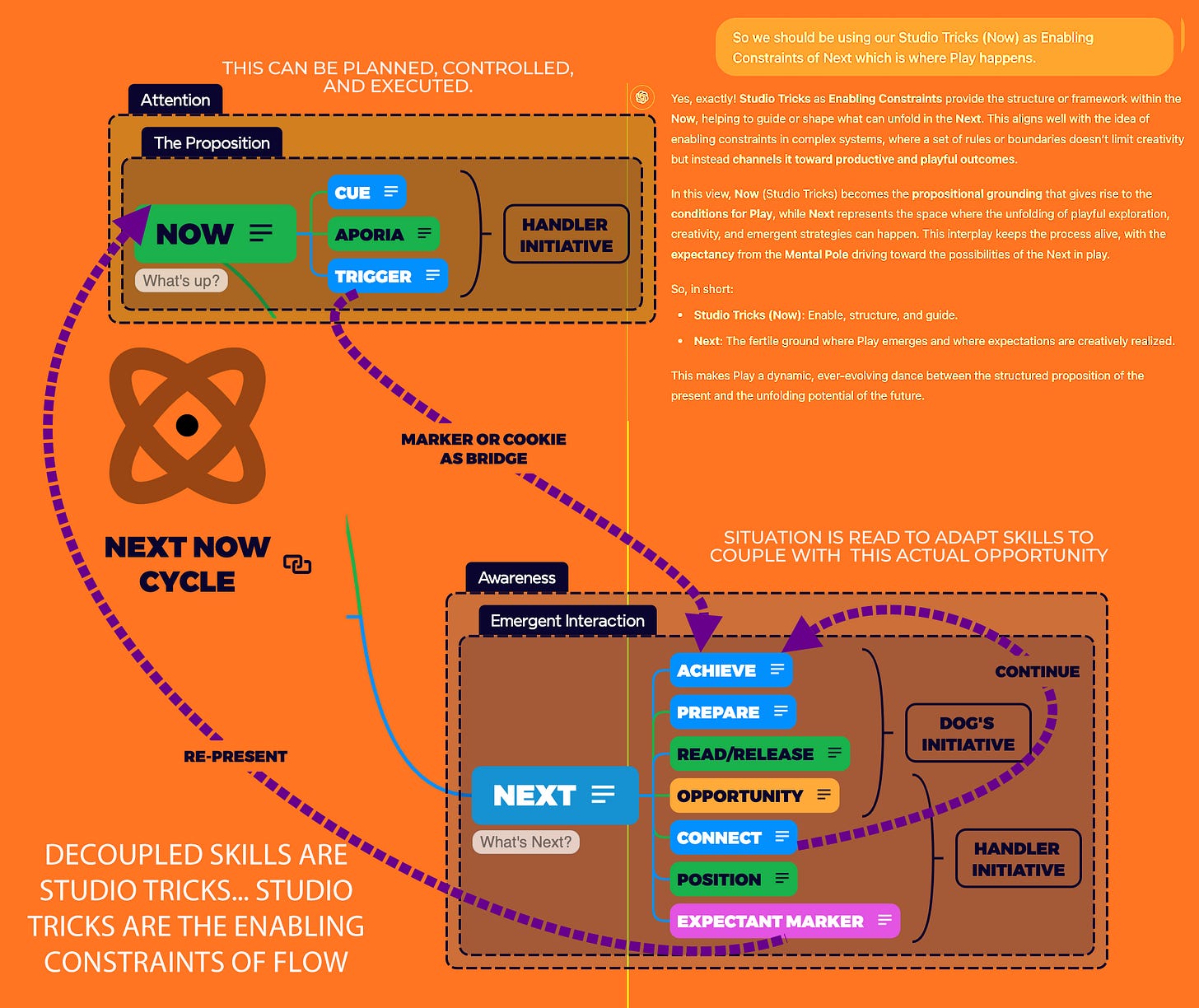On Being Present: Exploring the Solution Space Part 2
Awareness Over Acquisition: Attuning to the Flow of Next → Now in Cooperative Play
Learning is about attending to things, rather than acquiring the knowledge that absolves us of the need to do so.
Tim Ingold
Consequent opportunities & Initiative Transfers are the things we are attending to while playing. Our gaze control and Awareness picks up the relevant information that becomes our knowledge; this is true for dog and handler.
Dogs are already performing gaze control, and utilizing their Awareness — reading you like a book from afar for the information relevant to hooking up with you to complete this skill (aka: coupling).
Are you aware of those actions and plans by the dog, these moments of coupling? PLAY+ marks them and uses them as cookies. Let’s go check it out & explore and deepen our Awareness of cooperative play.
Prospective Reading - Following the Future
Prospective reading is a key aspect of cooperative play that is easier done than said. All dogs and handlers, are looking into the environment to pick up information. Some of that information is special (specifying and invariant information). If we find those special pieces of information and keep a coupled relationship to them, they will tell us the future. This is prospective control:
Prospective Control: The regulation of action based on perceptual information that specifies future environmental states, enabling agents to guide movement toward anticipated outcomes rather than responding to current or past conditions. Uses variables like time-to-contact (tau) and optical flow patterns that specify what will happen, allowing direct perception to guide interception, avoidance, and collaborative timing without requiring prediction or calculation.
When you throw a ball to your dog, which direction will he or she turn after picking it up? How will they turn? Do you know that? Are you sure? What happens if you run to you are moving to your left as they get it?
How will your dog turn at 30 yards? How will your dog turn if there’s a tree in the way or it goes behind the fence? What if he can’t find it?
That return is going to be different on every throw, in every environment. It will change, subtly or seriously, with every different position the handler could possibly be in. These are relational skills, not isolated behaviors.
PLAY+ asks the handler to do what all dogs do: be Aware of the relevant information in the solution space. It’s not hard, your dog can do it, but you got to watch and look; not like you’re looking for an answer or for your keys, but like you’re admiring a sunset or a landscape. You’ll then be able to see the dog moving clearly, like a train slowly coming around the mountain on a scenic vista. When you look like that everything slows down and you’re completely ahead of the game.
This type of looking, more like listening with your peripheral vision, is part of gaze control. And, like most of the stuff we’ve talked about, everybody’s doing it at least in some situations, just not aware of it. You’re now aware of it. Look for it.
Remember that paying attention is Awareness, it’s not focus.
Awareness is the guide & governor of uninhibited, focused Attention. Awareness precedes Attention, both situating and shifting attentional focus in relation to the environment, task, and handler.
Awareness is a skill as well as a state of being. It is not a thing or an action. When this balance is directed and seeks to fit with information picked up, welcome to the present.
You are being present.
Awareness needs to be tuned; attuned to environment and task so we can pick up relevant information like cues, triggers, equipment, dangerous obstacles, fences, distance to the dog, speed of dog, speed of handler, distance to the handler, angles, etc.
And we just pick it up, too. It’s not doing physics and math in our head, or making plans, but like how we find and use information to flawlessly stop the car at the corner after mindlessly slowing our roll to the stop sign while we’re adjusting the radio. Or when we - whoosh-whoa! - duck under a low doorframe. Awareness picks up all that information if Attention ain’t stealing it– SQUIRREL!
Awareness inhibits and directs Attention. It is our natural mode. We whack our heads or wind up rolling out into traffic when engrossed in our phone or focused on the radio because Attention shrinks Awareness.

Directing Our Aim - Awareness & Attention to Fit
We have an Aim, and Awareness’s job is to keep the Aim on track and to shift attention if needs be. Attention’s job is to do the thing. Our Aim is a subjective Aim, subjective in that both dog and handler got one, and they ain’t the same.
We want a harmonized Aim, fit to dog, handler, and task for this environment. This requires the inhibition of Attention of both dog and handler towards irrelevant details so our Awareness can pick up and couple with the information needed to adapt the skills to fit.
If we share an aim: handler wants the dog to catch, dog wants to catch, we’re good. If the Aims are close enough that we can do the skill, the skill is likely to happen. If our Aims are at odds, I want the jump and the dog wants the cookie, there could be trouble.
Ideally the team have a shared Aim which is what PLAY+ shoots for. So now my dog isn’t looking for the opportunity to get the toy or a cookie, my dog is aware of jump entry opportunities. Awareness and a shared Aim are what Primal Games create and cultivate through playful exploration rather than high stakes training or important behavioral acquisition.
Oriented by Action - Handling vs Training
Action creates information. When you move the whole world lights up with information. Most of it is not relevant, so we don’t pay attention to it, we are unaware of it. And most of us are moving like crazy doing all the things, but we’re not picking up task and partner relevant information, we’re not even looking for it — too busy doing behaviors, working the dog, and occupied by the mechanics of training.
Being present is attending to task relevant information in real time, being a bad ass dog handler is knowing what information is relevant and attending to it while letting the other stuff slide on by.
Handlers move to create a dynamic positional relationship with the dog. Trainers move the hands to move the dog. If you are a trainer and took offense to that, start moving, you’ll be a better trainer. If you’re offended because you are a trainer and move while learning, you’re handling, so good work. Take the compliment.
Training and Handling are the mental and physical aspects of working with dogs.

Action Creates Information
When someone with initiative moves, the game moves with them. The easiest way to seize the initiative is to move. You see people reset all the time, right? That is a play for initiative through acting to change the relationship between dog, handler, and task, in the environment.
Handlers act to create information and to change the environment. The dog who reads and responds to that action responds to handling. Mark these responsive moments, the moments of coupling, to bring the dog in on the process and turn emergent interactions into intentional Skills.
Markers collapse Awareness into Attention and actions marked in flow create a dialogue of Awareness and Attention that is shared intent. This shared information is memorable and meaningful, and creates a shared understanding. This shared understanding of process and flow is that process thing we want to bring the dog in on which shapes and harmonizes the Aims and Awareness of both dog and handler.
Through the handling lens, the cookie is information, affirmation, and initiative. Who doesn’t want that?

What’s Next?
The moment Now is done, Next is happening. Boom-Pow!
Orienting to Next means paying attention. If I throw the cookie and simply watch instead of zoning out, focusing on getting prepared, or making a value judgement on performance, I’ll notice things about the situation. Let’s say my dog is getting confused and is jumping on the pedestal instead of coming back to me:
Boom-pow, dog’s in good shape. Let’s go! Awareness FTW!
Handling dogs is about leading What’s Next? by being aware of the environment and our place within it. Anybody comfortable working with dogs does this, yet we do it intuitively or instrumentally and take it for granted, much like rolling up to the stop sign or avoiding hazards. This intuitive understanding of now informing next and our too busy doing it mentality allow our Attention to get away from us: do the thing, get the behavior, do it right — Awareness shrinks with Attention.
Next is the emergent phase of interaction this is where play happens. Play is an emergent activity. This is Awareness’ Jam. There are no reward schedules, protocols, methodologies, philosophies or online videos that are going to tell you where and how to move to facilitate this clean entry or your next action.
You’ve got to read the room, keep your wits about you, not get distracted, use the information on hand to move to meet the dog.
Stay tuned for Part III | How Release Becomes Rhythm and Awareness Moves the Game
Join my classes by becoming a Patron of Pawsitive Vybe - or join the substack here – it is embarrassingly cheap. Stay tuned... This place is gonna drop some serious content even for freebie-friends, so subscribe in order to keep up with the happenings & opportunities to play.
Peace & Happy Jamming!

